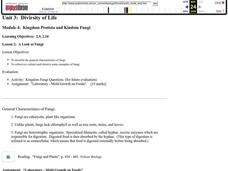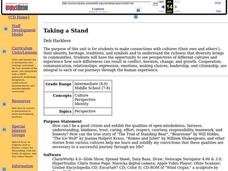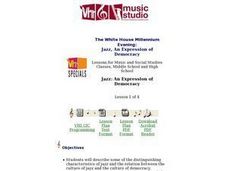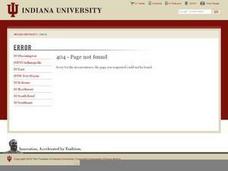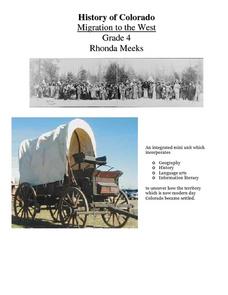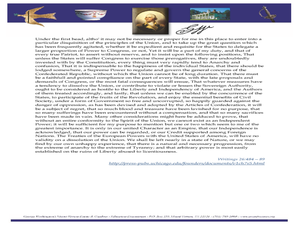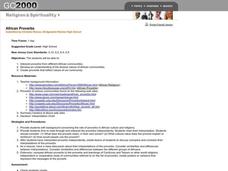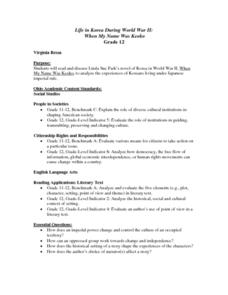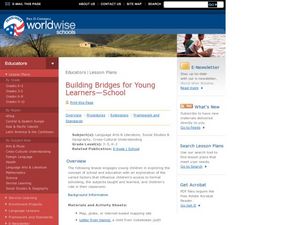Curated OER
Diversity of Life
Students study fungi and its characteristics. In this fungi lesson students collect and observe fungi then answer questions on what they saw.
Curated OER
Taking a Stand
Students make connections with cultures (their own and others'), their identity, heritage, traditions, and symbols and examine the richness that diversity brings to communities.
Curated OER
Lesson Plan for Korea
Students explore the results when conflicting cultures collide. They observe that often dominant cultures have tried to impose their will on others, with little or not thought about the effects on the people.
Curated OER
Non-Western Economic Values
Students engage in a game of economic exchange that present a variety of perspectives on wealth. They read scenarios and write a journal response to the scenario. They discuss how we use money in the Western culture and discuss how...
Curated OER
Africa South of the Sahara Today
Students describe and analyze cultural exchange projects that link students in all parts of the world. They write a report about the Ghana project of Morgan City High School.
Curated OER
"Almaden" by Kim Chi-won
Fourth graders read "Almaden" about a Korean woman living in New York. They give a brief background on Korean history and culture and discuss point of view. In groups, they work on discussions questions together.
Curated OER
Most Wonderful Gift
Learners discover that folktales reveal a great deal about the place in which they originate. They identify physical and human characteristics of a place and explain how culture influences the way people think. They illustrate cultural...
Curated OER
Timeline of Tijuana Estuary Populations
Students examine the various populations that have made their home in the Tijuana Estuary. In groups, they read an article and note the name of each population, facts and what tools they used in a journal. They use colored notecards to...
Curated OER
Jazz: An Expression of Democracy
Students watch a video segment about the distinguishing characteristics of jazz. They describe those characteristics and the relation between the culture of jazz and democracy. They improvise simple rhythms and melodies.
Curated OER
Welcome To Wales
Fourth graders explore the the culture and geographical region of Wales. After reading a picture book on Wales, 4th graders compare and contrast life in Wales to that in the United States. Given a camera, students develop their own...
Curated OER
Lesson Plans for 2nd grade Japan Unit
Second graders explore the music and dance of Japan in this five lessons unit. Aspects of Janpanese and American culture are compared. The food, holidays, clothing, and the school day of the two countries are discussed.
Curated OER
History of Colorado-Migration to the West
Fourth graders identify reasons for people moving to the Colorado Territory and examine how moving in the 1800's is different than moving today. They also practice reading maps and gathering information from maps, as well as, describe...
Curated OER
What Is In A Name?
Fourth graders investigate the meaning of names and how they are used to name geographic places. They conduct research using a variety of resources. Special attention is paid to names given within the Native American culture. Students...
Curated OER
Place In The World
Twelfth graders explore their social, cultural and political surroundings. They explore the responsibility and power individuals have as writers. In groups, 12th graders examine the works of Henry David Thoreau. After spending time...
Curated OER
Lesson 8: Early History of Illinois/Dual Timeline
Pupils, in groups, research and pretend as if they are interviewing a Mississippian child. They come up with three questions to ask to research their culture.
Curated OER
A Whale of a Difference
Students research various perspectives on Japan's commercial whaling industry and formulate position papers representing these views. They read the Times article, Yuk! No More Stomach for Whales. Groups present their perspectives on...
Curated OER
The Japanese Military Build-up
Students evaluate the state of Japan's military and their defense strategy under the current Shinzo Abe administration. They watch the film, 'The Raping of Nanking' and read "The Return of Japanese Militarism: Rising Sun" by Joshua...
Curated OER
George Washington & the Classics
Students will compare and contrast famous philosophers with George Washington. For this history lesson, students work in small groups to define Classicism, Legalism, Democracy, Republic and Civility, then read some short excerpts so...
Curated OER
African Proverbs
High schoolers read, interpret and research African proverbs to help them examine the diverse communities in Africa. Students write their own proverbs that reflect their own community and its values.
Curated OER
Life in Korea During World War II: When My Name Was Keoko
Twelfth graders review facts about roles of Asia and Japan in World War II, read When My Name Was Keoko to familiarize themselves with daily life and historic events during World War II in Korea, and participate in student-led...
Curated OER
The Harlem Renaissance
Students, after researching/analyzing the movement "Harlem Renaissance" and Africa as well as reading literature from that time period, create lists of the major characteristics of the movement and its important writers. They bridge the...
Curated OER
Building Bridges for Young Learners- School
Young scholars examine the purpose of education. In this schooling lesson, students read a letter from a child in Uzbekistan. Young scholars compare and contrast their schooling to children around the world.
Curated OER
Arthur Miller and The Crucible
Students investigate the dramatic elements of The Crucible. In this drama lesson, students explore the elements and themes of the Arthur Miller play as they read the play and watch performances of some of the acts. Students then write...
Curated OER
Through Many Lenses: How are Countries Depicted By the Media
Students read various sources about a country to understand viewpoints about that country. In this country lesson, students recognize that different sources portray different organizations differently. Students compare how different...


